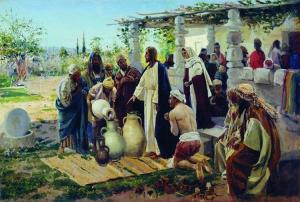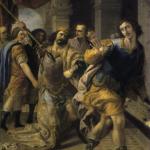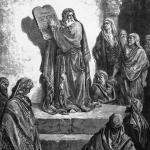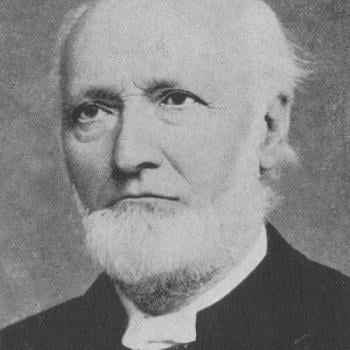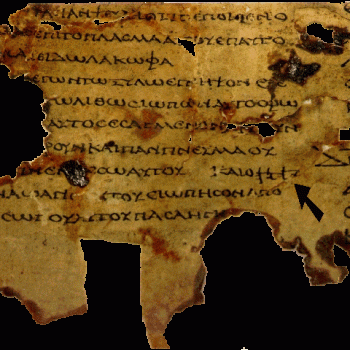John 2:1-2, 6, 11 (RSV) On the third day there was a marriage at Cana in Galilee, and the mother of Jesus was there; [2] Jesus also was invited to the marriage, with his disciples. . . . [6] Now six stone jars were standing there, . . . [11] This, the first of his signs, Jesus did at Cana in Galilee, and manifested his glory; and his disciples believed in him.
I differ with the standard acceptance of Cana, thought to be located at Kefr / Kafr Qana (the place our guide took us to when I visited Israel in 2014), and opt for Khirbet Qana, as a result of more recent research. Here are a few summary statements,
Recent excavations have tipped the scale decisively in favor of Khirbet Qana as the location of Cana . . .
Footnote: Excavations [since 1998] have been under the direction of Douglas Edwards (1) (University of Puget Sound) and Jack Olive (Pacific Lutheran University) in association with the Israel Antiquities Authority. . . .
[S]cholarly opinion has shifted to Khirbet Qana as New Testament Cana, a deduction now being borne out by the excavations (begun in 1998). (2)
Biblical Cana is best identified with Khirbet Qana, a low hill on the north side of the Beth Netofa Valley. (3)
A first-century date for the construction beneath the Roman church [at Kefr Qana: the currently most widely accepted claimant for Cana] has never been established, . . . A more likely choice for ancient Cana is Khirbet Kana . . . (4) (5)
The article “Cana” in the Catholic Encyclopedia, written by Bernard Ward in 1908, notes,
No direct indication can be gathered of its locality, except that it was not far from either Nazareth or Capharnaum, and higher than the latter city, . . . and that an ordinary traveler from Jerusalem to Nazareth would pass through or near it. . . . An old tradition identifies the site of Cana with modern Kefr’ Kenna, a village of about 600 inhabitants. . . . The tradition dates back at least to the eighth century, and probably a good deal earlier, . . .
In the section “Kafr Kanna” in a book about old churches in Israel, Denys Pringle writes,
In the twelfth century, Cana of Galilee came to be generally identified with Khirbat Qana (q.v.), a site lying 8.5 km [5.3 miles] to the north-north-west. The earlier tradition which identified Cana with Kafr Kanna, however, never seems to have been entirely supplanted, and from the mid fourteenth century it began to reassert itself . . .
Unfortunately no proper archaeological examination of this early [synagogue?] building was made before the new church was built [by the Franciscans in 1881]. Although its precise character remains uncertain, however, it seems very probable that it was in origin a synagogue of the third or fourth century AD . . . (The Churches of the Crusader Kingdom of Jerusalem: A Corpus: Volume 1, A-K (excluding Acre and Jerusalem), Cambridge University Press, 1993, p. 285)
James H. Charlesworth offers somewhat ambiguous information,
Where is Jesus’ Cana — the Cana mentioned in Jn 2? After three seasons of excavating, Peter Richardson and Douglas Edwards have most likely located [it] . . . It is Khirbet Cana. Since the sixth century C.E. it also has been venerated as the Cana of the Gospel of John. . . . The first century C.E. houses at Khirbet Cana are reminiscent of those at Capernaum and Yodefat . . .
It is unlikely, however, that the so-called synagogue dates to the time of Jesus, and probably was constructed in the late second or third century C.E. (6)
But he clarified elsewhere in his book, in a “Postscript,” drawing a conclusion that is more hopeful for this site being Cana:
The question of a synagogue at Khirbet Qana, discussed above, has been clarified since 2000: the public building in the southwest corner of the hilltop is certainly a synagogue, from the second century C.E. at the latest. [my italics] (7)
Urban C. von Wahlde adds very helpful (if not decisive) historical information:
In his clear and careful study, Herrojo shows that the earliest reports (those of Josephus, Eusebius, Jerome), all locate Cana at Khirbet Qana. (8) Furthermore, in his evaluation of the reports up to the time of the Crusaders, Herrojo concludes that throughout this period there was no evidence of any doubt regarding the town’s location. Herrojo analyzed each tradition and evaluated it in terms of its likely accuracy. In none of the descriptions could Cana’s location be associated with Kefr Kenna either with “certainty” or even with “high probability,” and while at times the reports were unclear, no description was incompatible with Khirbet Qana. Consequently, Herrojo concluded that up to the time of the Crusaders there was only a single tradition of Cana’s location, and this was consistently associated with Khirbet Qana. . . .
Herrojo concludes that Kefr Kenna and Khirbet Qana are recognized as distinct locations and are not confused. During this [Crusader] period ten pilgrim reports “certainly” identify Cana with Khirbet Qana and four others do so with “great probability.” In addition, three are “ambiguous” and could refer to either place. None “certainly” identify Cana with Kefr Kenna; none are incompatible with Khirbet Qana. Finally, no report indicates doubt about the location of the town. In short, the results throughout the Crusader period are the same as for the earlier periods. (10) [Footnote: This refutes the argument of those who have proposed that the Crusaders introduced the tradition of Khirbet Qana and that this interrupted the otherwise consistent tradition of associating Cana with Kefr Kenna]
The first indication of Kefr Kenna as a site of pilgrimage is in 1566, when a Greek Orthodox church is built there. . . . The first written indication of any uncertainty about the location of biblical Cana is expressed in the book of Francisco Quaresmio in 1626. (11)
Herrojo noted that two events between 1630 and 1640 started the trend of Kefr Kenna being regarded as Cana: Khirbet Qana was depopulated and fell into ruins, and the purported tomb of Jonah there was abandoned. Up until that time, pilgrims (including Franciscans) continued to regard Khirbet Qana as the biblical Cana. Hence, the reasons for the change obviously had nothing to do with archaeology or other historical indicators of authentic traditions and locations.
Tom McCollough, who has directed the excavations at Khirbet Qana, describes another piece of evidence found there:
We have uncovered a large Christian veneration cave complex that was used by Christian pilgrims who came to venerate the water-to-wine miracle. This complex was used beginning in the late fifth or early sixth century and continued to be used by pilgrims into the 12th-century Crusader period. The pilgrim texts we have from this period that describe what pilgrims did and saw when they came to Cana of Galilee match very closely what we have exposed as the veneration complex. . . .
His [Josephus’] references to Cana align geographically with the location of Khirbet Qana . . . (12)
The article also notes that “amazingly, an altar and a shelf hold the remains of a stone vessel with room for five more.” (13)
Perhaps tour guides and those who research biblical archaeology can be excused for (I believe) mistakenly identifying Cana as Kefr Kenna, since Herrojo’s work was only available in 1999 (and in Spanish), and excavations at Khirbet Qana were only undertaken in 1998. But now we know a lot of things that we didn’t know before, and they appear to me to be quite decisive.
FOOTNOTES
1) See: Douglas R. Edwards, “Khirbet Qana: from Jewish Village to Christian Pilgrimage site”, The Roman and Byzantine Near East, vol. 3. Portsmouth, Rhode Island: Journal of Roman Archaeology, ed. John H. Humphrey, 2002, 101-132. See an Appendix (by Danny Sion) to this article concerning coins.
2) Peter Richardson, “Khirbet Qana (and Other Villages) as a Context for Jesus”, in Jesus and Archaeology, edited by James H. Charlesworth (Grand Rapids, Michigan: Eerdmans, 2006), 120-121.
3) Mark T. Schuler, “Recent Archaeology of Galilee and the Interpretation of Texts from the Galilean Ministry of Jesus” (Concordia Theological Quarterly, Vol. 71:2, April 2007, 99-117); citation from p. 105.
4) John McRay, Archaeology and the New Testament (Grand Rapids, Michigan: Baker: 1991), 174.
5) See many photographs of the site at “Khirbet Cana” (BibleWalks).
6) Charlesworth, ibid., 39-40. Accessed via Amazon’s “Look Inside” function.
7) Ibid., 144.
8) J. Herrojo, Cana de Galilea y su localizacion: Un examen critico de las fuentes (Paris: J. Gabalda, 1999), 22-35, 45.
9) Herrojo, 36-45.
10) Herrojo, 46-88.
11) Urban C. von Wahlde, chapter: “Archaeology and John’s Gospel,” in Charlesworth, ibid., 540-541. Accessed via Amazon’s “Look Inside” function.
12) in Neal Baker, “Experts say lost tunnels in Israel could be where Jesus turned water into wine,” New York Post, August 30, 2018.
13) Baker, ibid.
***
Practical Matters: Perhaps some of my 4,200+ free online articles (the most comprehensive “one-stop” Catholic apologetics site) or fifty-one books have helped you (by God’s grace) to decide to become Catholic or to return to the Church, or better understand some doctrines and why we believe them.
Or you may believe my work is worthy to support for the purpose of apologetics and evangelism in general. If so, please seriously consider a much-needed financial contribution. I’m always in need of more funds: especially monthly support. “The laborer is worthy of his wages” (1 Tim 5:18, NKJV). 1 December 2021 was my 20th anniversary as a full-time Catholic apologist, and February 2022 marked the 25th anniversary of my blog.
PayPal donations are the easiest: just send to my email address: [email protected]. You’ll see the term “Catholic Used Book Service”, which is my old side-business. To learn about the different methods of contributing, including 100% tax deduction, etc., see my page: About Catholic Apologist Dave Armstrong / Donation Information. Thanks a million from the bottom of my heart!
***
Photo credit: Miracle at Cana (1887), by Vladimir Makovsky (1846-1920) [public domain / Wikiart]
***
Summary: Where is the wedding site at Cana? Tour guides and tour maps tell us one thing, but archaeological consensus increasingly points to an abandoned nearby town.


